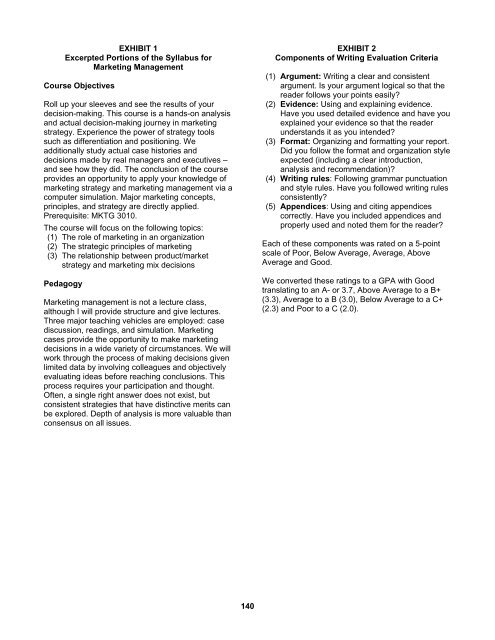2008 - Marketing Educators' Association
2008 - Marketing Educators' Association
2008 - Marketing Educators' Association
Create successful ePaper yourself
Turn your PDF publications into a flip-book with our unique Google optimized e-Paper software.
EXHIBIT 1<br />
Excerpted Portions of the Syllabus for<br />
<strong>Marketing</strong> Management<br />
Course Objectives<br />
Roll up your sleeves and see the results of your<br />
decision-making. This course is a hands-on analysis<br />
and actual decision-making journey in marketing<br />
strategy. Experience the power of strategy tools<br />
such as differentiation and positioning. We<br />
additionally study actual case histories and<br />
decisions made by real managers and executives –<br />
and see how they did. The conclusion of the course<br />
provides an opportunity to apply your knowledge of<br />
marketing strategy and marketing management via a<br />
computer simulation. Major marketing concepts,<br />
principles, and strategy are directly applied.<br />
Prerequisite: MKTG 3010.<br />
The course will focus on the following topics:<br />
(1) The role of marketing in an organization<br />
(2) The strategic principles of marketing<br />
(3) The relationship between product/market<br />
strategy and marketing mix decisions<br />
Pedagogy<br />
<strong>Marketing</strong> management is not a lecture class,<br />
although I will provide structure and give lectures.<br />
Three major teaching vehicles are employed: case<br />
discussion, readings, and simulation. <strong>Marketing</strong><br />
cases provide the opportunity to make marketing<br />
decisions in a wide variety of circumstances. We will<br />
work through the process of making decisions given<br />
limited data by involving colleagues and objectively<br />
evaluating ideas before reaching conclusions. This<br />
process requires your participation and thought.<br />
Often, a single right answer does not exist, but<br />
consistent strategies that have distinctive merits can<br />
be explored. Depth of analysis is more valuable than<br />
consensus on all issues.<br />
140<br />
EXHIBIT 2<br />
Components of Writing Evaluation Criteria<br />
(1) Argument: Writing a clear and consistent<br />
argument. Is your argument logical so that the<br />
reader follows your points easily?<br />
(2) Evidence: Using and explaining evidence.<br />
Have you used detailed evidence and have you<br />
explained your evidence so that the reader<br />
understands it as you intended?<br />
(3) Format: Organizing and formatting your report.<br />
Did you follow the format and organization style<br />
expected (including a clear introduction,<br />
analysis and recommendation)?<br />
(4) Writing rules: Following grammar punctuation<br />
and style rules. Have you followed writing rules<br />
consistently?<br />
(5) Appendices: Using and citing appendices<br />
correctly. Have you included appendices and<br />
properly used and noted them for the reader?<br />
Each of these components was rated on a 5-point<br />
scale of Poor, Below Average, Average, Above<br />
Average and Good.<br />
We converted these ratings to a GPA with Good<br />
translating to an A- or 3.7, Above Average to a B+<br />
(3.3), Average to a B (3.0), Below Average to a C+<br />
(2.3) and Poor to a C (2.0).


